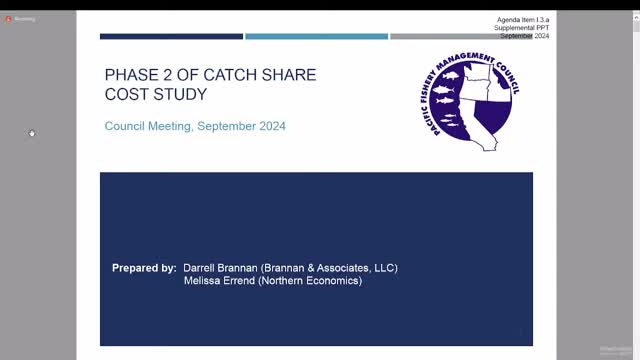Major report reveals soaring costs in fisheries monitoring programs
September 21, 2024 | Fishery Management Council, Pacific, Governor's Office - Boards & Commissions, Executive, Washington
This article was created by AI summarizing key points discussed. AI makes mistakes, so for full details and context, please refer to the video of the full meeting. Please report any errors so we can fix them. Report an error »

In a recent government meeting, officials discussed the findings of a comprehensive report on the economic data collection (EDC) and monitoring programs related to the West Coast catch share program. The meeting highlighted the significant costs associated with these programs and the potential implications of proposed changes.
The report, presented by economists from Northern Economics, outlined the objectives of the EDC program, which aims to provide crucial data for fisheries management. It was noted that the average annual cost of the at-sea monitoring program was approximately $2.2 million, while shoreside monitoring costs were around $1 million. The discussion emphasized the need to balance cost reductions with the program's effectiveness in ensuring compliance and accurate catch accounting.
Key findings revealed that the costs of monitoring varied significantly across different fleets, with catcher processors and motherships incurring the highest expenses due to the requirement for multiple observers. The report also explored various options for reducing costs, including lowering monitoring coverage rates and potentially eliminating shoreside monitoring requirements altogether. However, these changes could lead to decreased compliance and increased risks of exceeding catch limits, which could negatively impact stock assessments.
Council members expressed concerns about the implications of reducing monitoring coverage, particularly regarding the potential for unintentional changes in fishing behavior when observers are present. The discussion also touched on the importance of maintaining data quality for certifications, such as those from the Marine Stewardship Council (MSC), which could be jeopardized by reduced monitoring.
In addition to monitoring costs, the meeting addressed the EDC program's direct and indirect costs, which have seen a significant decline in recent years. The total costs for the EDC program were reported at $268,000 in 2022, down from $575,000 in previous years. This decline was attributed to the implementation of more efficient data collection methods.
The Groundfish Advisory Panel (GAP) recommended that the council accept the report as complete but urged further examination of the EDC program's costs and implications for program performance. They highlighted the need for a more detailed analysis of wage rates and the time required for reporting, as these factors significantly influence the overall cost burden on industry participants.
Overall, the meeting underscored the complexities of managing fisheries data collection and monitoring, balancing economic considerations with the need for sustainable practices and regulatory compliance. The council is expected to deliberate on the report's findings and recommendations in future sessions.
The report, presented by economists from Northern Economics, outlined the objectives of the EDC program, which aims to provide crucial data for fisheries management. It was noted that the average annual cost of the at-sea monitoring program was approximately $2.2 million, while shoreside monitoring costs were around $1 million. The discussion emphasized the need to balance cost reductions with the program's effectiveness in ensuring compliance and accurate catch accounting.
Key findings revealed that the costs of monitoring varied significantly across different fleets, with catcher processors and motherships incurring the highest expenses due to the requirement for multiple observers. The report also explored various options for reducing costs, including lowering monitoring coverage rates and potentially eliminating shoreside monitoring requirements altogether. However, these changes could lead to decreased compliance and increased risks of exceeding catch limits, which could negatively impact stock assessments.
Council members expressed concerns about the implications of reducing monitoring coverage, particularly regarding the potential for unintentional changes in fishing behavior when observers are present. The discussion also touched on the importance of maintaining data quality for certifications, such as those from the Marine Stewardship Council (MSC), which could be jeopardized by reduced monitoring.
In addition to monitoring costs, the meeting addressed the EDC program's direct and indirect costs, which have seen a significant decline in recent years. The total costs for the EDC program were reported at $268,000 in 2022, down from $575,000 in previous years. This decline was attributed to the implementation of more efficient data collection methods.
The Groundfish Advisory Panel (GAP) recommended that the council accept the report as complete but urged further examination of the EDC program's costs and implications for program performance. They highlighted the need for a more detailed analysis of wage rates and the time required for reporting, as these factors significantly influence the overall cost burden on industry participants.
Overall, the meeting underscored the complexities of managing fisheries data collection and monitoring, balancing economic considerations with the need for sustainable practices and regulatory compliance. The council is expected to deliberate on the report's findings and recommendations in future sessions.
View full meeting
This article is based on a recent meeting—watch the full video and explore the complete transcript for deeper insights into the discussion.
View full meeting
